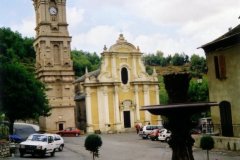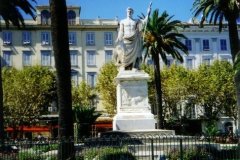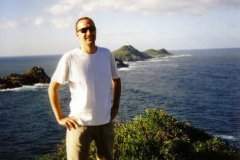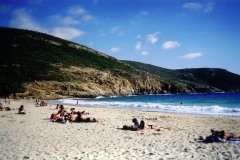The June 2003 issue of the csma’s monthly magazine Motoring & Leisure featured my travel article about Corsica – win a holiday on Corsica – “Corse you can” 🙂
Martin Mayhew’s holiday on this ruggedly lovely Mediterranean island even had a meal thrown in – literally!
There is nothing bland about Corsica. Tiny villages, often eerily empty, cling to the flanks of the granite and slate mountains which split the island; startlingly white-fringed beaches on the 1,000km of coastline are often remote and deserted; its language and food distinctive yet remarkably familiar.
Thirty years ago the island, described by proud Corsicans as a ‘mountain in the sea’, was relatively unknown as a holiday spot. Now it is tourism that supports the island’s economy, with two-thirds of visitors coming from France. An unusual fact is the Victorians were among the first travellers to spot Corsica’s attractions as a getaway destination. They built grand palaces in Ajaccio, the capital and famous as the birthplace of Napoleon Bonaparte.
The French come for the sun, the diving, the cycling, the climbing and the spectacular walking, especially on the renowned GR20, a hiker’s dream trail which cuts the island roughly into quarters and climbs over mountains and down into valleys. There is even skiing for winter sports fans. Corsica is blessed with much more than just stunning mountain scenery and secret beaches. My friends and I had heard that it was a quiet place to relax, something we were to dispute by the end of our holiday!
A trip up the dizzyingly narrow and often pitted roads of the island’s west coast is truly an adventure if a rather perilous one. Luckily the state of the roads dictates a low gear and near-pedestrian pace in parts. Facing you around any bend could be a lonesome cow; they graze freely in the maquis – the mountain scrub. You may even come across pigs snuffling for chestnuts. These chestnuts add a distinctive flavour to the local pork and are used in beer and bread making. You may spot a wild boar skin (with the head still attached) flung over a fence – it’s a show of an individual hunter’s success.
On the Journey along the west coast, you can sample the delights of wild boar at the Osteria u Mulinu in Feliceto, a village in the Balange region. Here the host served up thick slices of home-cured ham hacked off with a huge knife. The meal was literally thrown at us! Anything we failed to catch was simply thrown out of the window into the lane (and that included plates and glasses). The guilty party was then clouted around the ear; it was worse for the girls – they received a full-on garlic smacker on the lips! The evening proceeded at a lightning pace: pistols firing, whips a-cracking, singing and dancing; in fact a full-on cabaret by our eccentric host. By the end of the evening, topped up with local wine we were all singing and dancing too.
We lamented our dubious singing abilities during the walk back to our hotel, a stroll that commenced with our feet crunching over much of that and many previous evening’s broken crockery in the road. The brilliant panoply of stars overhead illuminated our way.
We were staying at the Renucci family’s 19th-century Hotel Mare e Monti. Monsieur Renucci is very proud of his home; one floor has been preserved as a museum from Napoleon III’s period, with the original furniture, carpets, wallpaper and objets d’art. Ask nicely and Mr Renucci will regale you with stories of his family’s fascinating history. Be sure to buy some of the wine and olive oil produced on his estate – it’s a taste sensation!
There is much evidence of Corsica’s dual personality everywhere. Many road signs and directions are depicted in French and also in Corsican – a hybrid of Italian and French. Many Corsicans still speak the Corsican dialect and quite a few favour independence from France.
There are many newer small seaside resorts tucked in tiny bays between the mountainous outcrops. Porto is well worth a visit. I stood on the small balcony of my hotel as the last glowing sliver of sun, perfectly framed by the rocks, dipped over the horizon on a strangely still sea. I have never seen such a stunning end to a day.
The island has a wealth of hidden treasures. On my next visit, I will make a point of visiting the south to explore the prehistoric sites around Sartene. I was told of huge menhir stone statues and dolmen built by early settlers, many featuring human faces. I wonder how closely they resemble the fiercely proud modern-day Corsicans. One thing we can be sure of – the ancient Corsicans would have regularly feasted on wild boar, but just how would they have served it up?
All rights of photos belong to Martin Mayhew 🙂
Here is page 85 of the same issue with the Paul McCartney interview by David “Kid” Jensen, which I believe was recorded for Capital Gold in 2001 (?)




















